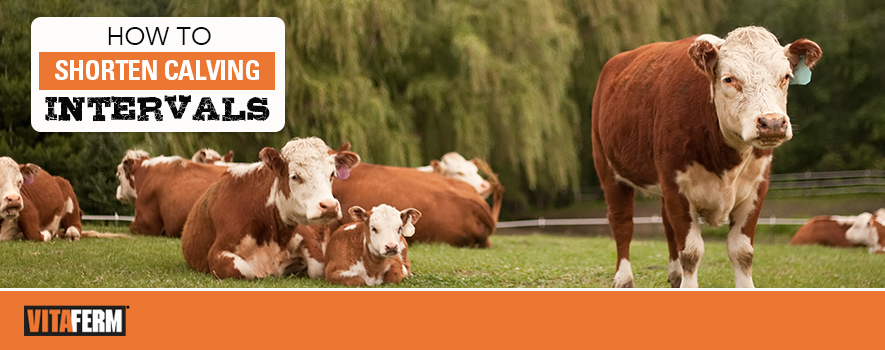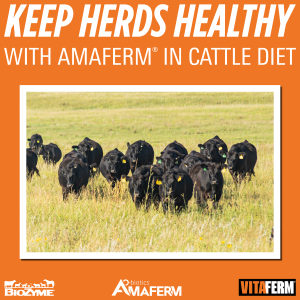
Optimum productivity should be the goal of each cow-calf producer and that productivity begins with cows producing at least one calf every 365 days. With proper management, including a good health and nutrition program, that goal is easily attainable.
Shortened calving intervals – or the time between birth of one calf and the subsequent birth of the next from the same cow – are beneficial to both the productivity and profitability of the herd. In addition, from a labor efficiency standpoint, it just makes sense to calve for a 60-day window instead of 120 or 150 days, causing twice the length of sleepless nights.
Let’s explore the four tips to shorten the calving intervals and the profit potential that producers can add to the herd when the calving windows are shortened.
- Start with a good nutrition program. A cow’s nutrient requirements are at their highest around breeding time. Not only is she trying to maintain her own body condition while in peak lactation to provide nourishment to a rapidly growing calf, but she is also trying to heal her own reproductive tract to support and maintain a new pregnancy. That is why it is absolutely pivotal to make sure she is getting the required amounts of vitamins, minerals, energy and protein needed to support adequate performance. In addition to these essential nutrients, Phosphorus and Vitamin E will help encourage repair of the reproductive tract and help her get ready to come into heat and breed back sooner. <p/> A product like VitaFerm® Concept•Aid® is specifically designed for reproductive success when fed 60 days pre-calving through 60 days post-breeding. Concept•Aid is especially beneficial in A.I. and E.T. breeding programs. It contains organic copper, zinc and manganese to ensure maximum bioavailability of nutrients to the animal, and also contains high levels of Vitamin E and Selenium to promote optimized fertility. Like all VitaFerm products, it contains Amaferm®, is a prebiotic designed to enhance digestibility by amplifying the nutrient supply for maximum performance. It is research-proven to increase intake, digestion and absorption.
Amaferm is research-proven to increase milk production and initiate and maintain pregnancy and fertility. <p/> “Concept•Aid has all the vitamins, minerals and other nutrients the lactating cow needs to help heal her reproductive tract and help her come into heat sooner,” said Lindsey Grimes-Hall, Nutrition Manager at BioZyme® Inc. <p/> - Use heat synchronization protocols. With the ever-advancing technology that is available for cattle producers, getting cows to come into heat at the same time, and more rapidly in easier than ever before. Technology like CIDR devices and timed A.I., can help tighten the calving window and get cows to come into heat sooner, resulting in a shorter calving window. <p/>
- Make sure your bulls are reproductively sound. Make sure your bulls have a breeding soundness exam (BSE) 30-60 days before turnout, and that they are semen tested. If they are not fertile, not only will you have a lot of open cows, your calving interval just got a lot longer when all of your females come into heat again for a second or third time before you realize the problem. <p/>
- Be disciplined and be aggressive. Be sure to mark your calendar, and when your breeding season is up, whether that is 60 days or 90 days, pull your bulls. And then, 30-45 days later, have your vet come and preg-check everything that has been exposed, either naturally or via A.I. This is when it is time to become aggressive and make some culling decisions. Perhaps you have a cow with great genetics that had some calving difficulty or another challenge that came up open. You must decide if it worth keeping her open for another calving season to see if she will heal and breed back or if it is time to sell her and replace her with new genetics.
Not only does the shortened calving interval benefit your cow herd and labor management at calving time, its primary benefit to the producer is at weaning or when it comes time to market the calf crop. For smaller operations that have one weaning season, the calves will be more uniform in size and tighter in weight, both preferred by buyers looking for load lots of calves to purchase.
“When the calving windows are spread out, Smaller calves won’t be as big and efficient because they will be pushed away from the bunk by bigger calves,” Grimes-Hall said.
By keeping the calving intervals shortened, calves will be uniform in size, giving them all the opportunity to stand at the bunk, gain and perform.
A growing calf every 365 days is an attainable goal. With good management practices, and sound nutrition and health program and plenty of rest for the producer, you can have tighter calving intervals, producing those calves on a more regular basis, and seeing more profit in your pocket each year.


